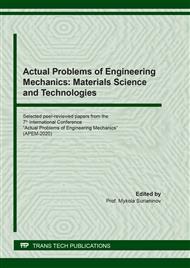[1]
K..Sobolev, M.Ferrada-Gutiurrez, How nanotechnology can change the concrete world, part 1, Am Ceram Soc Buii (2005) 84(10) 14-7.
Google Scholar
[2]
A.N. Ponomarev, High-quality concrete. Analysis of possibilities and practice of using methods of nanotechnology, Construction Engineering Magazine. 6 (2009) 25-33.
Google Scholar
[3]
M.E Ydovich, A.N. Ponomarev, S.I. Gareev, Surface-active properties of nanomodificated plasticizer, Construction matersals. 3 (2008) 2-3.
Google Scholar
[4]
V.A. Perfilov, U.V. Alatortseva, M.I. Dmitruk, Application of modifying nanoadditives for іncreased strength of fiber concrete, Proceedings of the universities. Construction. 8 (2009) 17-20.
Google Scholar
[5]
K.K. Pushkaryova, M.V. Sukhanevich, A.S. Martikh, Portland cement solutions modified with carbon nanotubes as a basis for waterproofing coatings, Building materials, products and sanitary engineering. 50 (2013) 31-37.
Google Scholar
[6]
M.A. Sanitsky, U.D. Marushchak, T.A. Mazurak, Nanomodified Portland cement compositions with high strength at an early age, Building materials, products and sanitary engineering. 57 (2016) 147–154.
DOI: 10.15587/1729-4061.2016.84175
Google Scholar
[7]
S.N. Tolmachev, O.A. Belichenko, Properties of fine cement concretes with carbonaceous nanoparticles, Proceedings of the 4-th International Conference on Concrete Repair, Taylor and Francis Group, 2011, p.313 – 324.
DOI: 10.1201/b11570-45
Google Scholar
[8]
V.N. Derevyanko, A.G. Chumak, and V.E. Vaganov, Influence of nanoparticles on the processes of hydration of semi-aqueous gypsum, Building Materials. 7 (2014) 22 - 24.
Google Scholar
[9]
K.K. Pushkaryova, M.V. Sukhanevich, A.S. Martsikh, Influence of carbon nanotubes on the processes of structure formation of slag cement cement,Visnyk ODABA. 57 (2015) 380-386.
Google Scholar
[10]
M.V. Sukhanevich, Comparison of the Efficiency of Using Different Carbon Nanosubstances for Modification of Cement Composite Materials, Building Materials and Products. 3-4 (95). (2017) 46-49.
Google Scholar
[11]
K.K. Pushkaryova, M.V. Sukhanevich, A.S. Martsikh, The use of complex additives containing carbon nanotubes and plasticizers for the modification of cement compositions, Building materials, products and sanitary engineering. 51 (2014) 14-20.
Google Scholar
[12]
K.Pushkarova., M.Sukhanevych, A.Marsikh, Using of untreated carbon nanotubes in cement composition, Materials Science Forum. 865 (2016) 6-11.
DOI: 10.4028/www.scientific.net/msf.865.6
Google Scholar
[13]
A.N. Plugin, A.A. Plugin, L.V. Trikoz et al, Fundamentals of the theory of hardening, strength, fracture and durability of Portland cement, concrete and structures. Colloid chemistry and physicochemical mechanics of cement concretes, part 1, Kiev: Scientific Thought, (2011).
Google Scholar
[14]
A.N. Plugin, A.A. Plugin, O.A. Kalinin, etc., Fundamentals of the theory of hardening, strength, fracture and durability of Portland cement, concrete and structures, Cement theory of Portland cement, part 2, Kiev: Scientific Thought, (2012).
Google Scholar
[15]
A.N. Plugin, A.A. Plugin, O.A. Kalinin, etc., Fundamentals of the theory of hardening, strength, fracture and durability of Portland cement, concrete and structures, The theory of strength, destruction and durability of concrete, reinforced concrete and their structures, part 3, Kiev: Scientific Thought, (2012).
DOI: 10.14359/51688570
Google Scholar
[16]
Pluhin A.A., Pluhin O.A., Borziak O.S., Kaliuzhna O.V. (2020) The Mechanism of a Penetrative Action for Portland Cement-Based Waterproofing Compositions. In: Blikharskyy Z., Koszelnik P., Mesaros P. (eds) Proceedings of CEE 2019. CEE 2019. Lecture Notes in Civil Engineering, vol 47. Springer, Cham.
DOI: 10.1007/978-3-030-27011-7_5
Google Scholar


